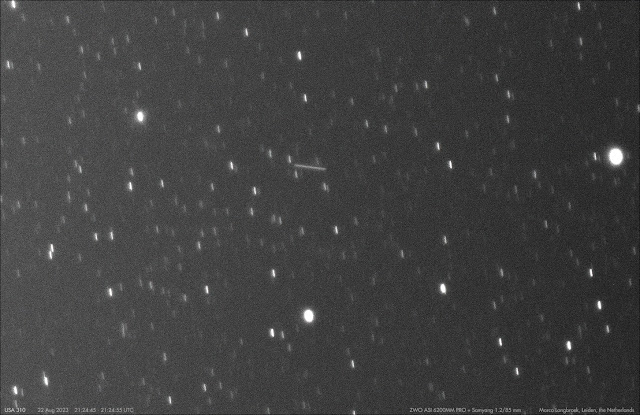 |
| click image to enlarge |
Our coverage of classified objects in high altitude orbits has been waning over the past few years. In February, I made a first attempt to recover some. In the past two weeks, I again recovered a number of these objects, as a by product of testing a ZWO ASI6200MM camera (that ultimately is going to be installed on the roof of the Delft Technical University Aerospace faculty).
One of the objects I recovered, is a very unusual one: USA 310 (2020-083A). This object is in an odd 58.5 degree inclined, 11097 x 11074 km MEO orbit. It was launched on 13 November 2020 as NROL-101 (see this 2020 blogpost). We tracked it and it's Centaur upper stage for a couple of weeks, but lost it after February 2021. In other words: it had not been seen for the last 2.5 years!
That is, untill I serendipitously picked it up last August 22, while imaging geostationary satellites. In the imagery, a streak was encountered (see image above). It is a fit with USA 310. I managed to track it again during several nights the past two weeks. Frankly, I am not 100% sure whether it is USA 310 or the Centaur upper stage from that launch, but it does not seem to have the periodic brightness variation the Centaur upper stage showed in 2020/2021. And it is (relatively) bright only in the eastern part of the sky, just like USA 310 back in 2020/2021.
More objects were recovered. Several geosynchronous objects that hadn't
been observed for a while, were imaged. One of them, the enigmatic PAN (2009-047A), had moved (just as it used to frequently do in the past, see my in-depth article on PAN in The Space Review from October 2016). I recovered it at longitude 39.7 degrees East, in the vicinity of Express AM-7. Observations over the past two week show it is stationkeeping, so it appears to be still operational (see also this post from 2021, when after several years of being stable at 47.7 E, it started to drift). Below is the recovery image:
 |
| click image to enlarge |
Coverage of high altitude objects in HEO has likewise become spotty. I observed a number of them late February (see this blogpost), and again did so the past two weeks (a.o. TRUMPET 1 and USA 278). I recovered the SIGINT satellite TRUMPET-2 (1995-034A) on September 5, which had not been seen for almost 2 years:
One reason why I only sporadically track objects in GEO and HEO is that identifying and measuring them is much more labour-intensive than video-tracking objects in Low Earth Orbit, as identifying and measuring is still done manually for these objects by me. One day, I should get myself some software to make this a more easy task...

No comments:
Post a Comment
Note: only a member of this blog may post a comment.